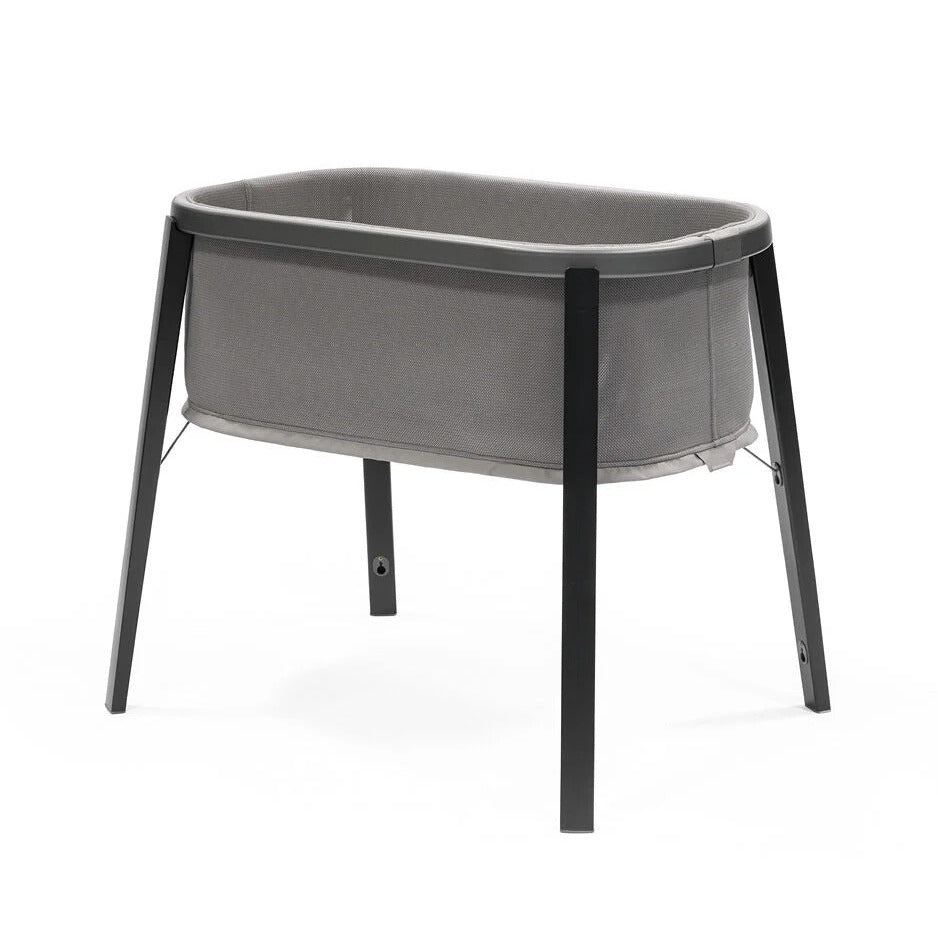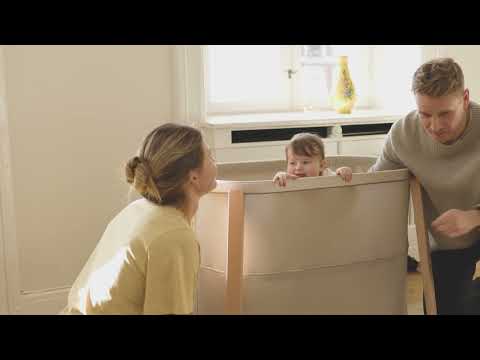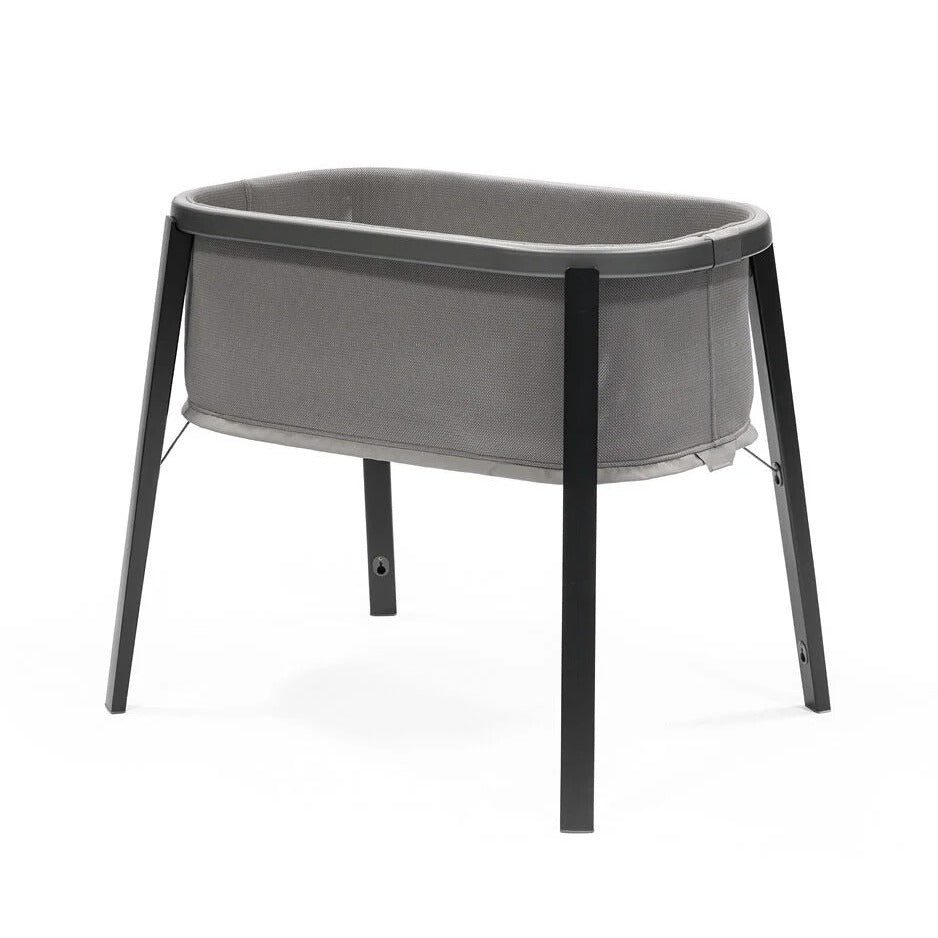Stokke Snoozi Bassinet
Stokke Snoozi Bassinet
SKU:629602
Clothing Prem to 18 Months
| Size | Age Guide | Weight | Height |
|---|---|---|---|
| Premature | Premature or Small Newborn | Up to 4Kg | Up to 55cm |
| Newborn | 0-3 months | 4-6Kg | Up to 62cm |
| 3 Month | 3-6 months | 6-8Kg | Up to 68cm |
| 6 Month | 6-12 Month | 8-10Kg | Up to 76cm |
| 12 Month | 12-18 Month | 10-12Kg | Up to 84cm |
| 18 Month | 18-24 Month | 12-14Kg | Up to 92cm |
Clothing 2 to 6 Years
| Size | Age Guide | Height | Chest | Waist | Hip |
|---|---|---|---|---|---|
| 2 Year | 2-3 Years | Up to 100 cm | 56 | 51 | 58 |
| 3 Year | 3-4 Years | Up to 105 cm | 58 | 53 | 60 |
| 4 Year | 4-5 Years | Up to 110 cm | 60 | 55 | 62 |
| 5 Year | 5-6 Years | Up to 115 cm | 62 | 57 | 64 |
| 6 Year | 6-7 Years | Up to 120 cm | 64 | 59 | 66 |
Beanie Size Guide
| Size | Head Circumference | Age Guide |
|---|---|---|
| Premature | 31-35 cm | Premature or Small Newborn |
| Newborn | 35-40 cm | Newborn |
| Small | 40-43 cm | 3-6 Months |
| Medium | 43-47 cm | 6-18 Months |
| Large | 47-52 cm | 18-3 Years |
Sunhat Size Guide
| Size | Head Circumference | Age Guide |
|---|---|---|
| Newborn | 37-40 cm | Newborn |
| Small | 40-43 cm | 3-6 Months |
| Medium | 43-46 cm | 6-12 Months |
| Large | 46-49 cm | 12-24 Months |
| Xtra Large | 49-54 cm | 2-4 Years |
Sleep Pods Size Guide
| Size | Weight | Age Guide | Measurement(Back to Hem) |
|---|---|---|---|
| Newborn | 0-6 kgs | 0-3 Months | 60.5 cm |
| Small | 0-8 kgs | 3-6 Months | 66 cm |
Booties Size Guide
| Size | Age Guide |
|---|---|
| Newborn | 0-3 Months |
| Small | 3-6 Months |
| Medium | 6-12 Months |
| Large | 12-18 Months |
Pretty Brave Baby
| Foot Length (mm) | Insole Length (mm) | EU | UK | Age | INT |
|---|---|---|---|---|---|
| 95-104 | 110 | 16/17 | 2 | 0-6m | S |
| 104-114 | 118 | 18 | 3 | 6-12m | M |
| 114-123 | 127 | 19/20 | 4.5 | 12-18m | L |
| 123-137 | 142 | 21/22 | 5.5 | 16-22m | XL |
Pretty Brave 1st Walker
| Foot Length (mm) | Insole Length (mm) | EU | UK | Age |
|---|---|---|---|---|
| 114-120 | 125-128 | 19 | 3 | 1 yr |
| 120-126 | 132-135 | 20 | 3.5 | 1-2 yrs |
| 126-132 | 138.5-141.5 | 21 | 4.5 | 1-2 yrs |
| 132-138 | 145-148.5 | 22 | 5 | 2 yrs |
Crywolf Swim Nappy
| Size | Length (waist to crotch) | Crotch Width (side to side) |
|---|---|---|
| 0-1 yr | 1-2 yrs | |
| 37 | 38 | |
| 14.5 | 15.5 |
Crywolf Rash Suit
| Size | Length (back neck to crotch) | Chest (arm to arm) | Waist (side to side) | Sleeve (neck to cuff) | Neck Opening(diameter) |
|---|---|---|---|---|---|
| 6-12 Months | 1 yr | 2 yrs | 3 yrs | ||
| 40 | 42 | 44 | 46 | ||
| 25 | 26 | 27 | 28 | ||
| 24 | 25 | 26 | 27 | ||
| 30 | 31.5 | 33 | 34.5 | ||
| 13.25 | 13.25 | 13.8 | 14.3 |
Low stock
Couldn't load pickup availability
Overview
Overview
Keep your baby close and comfortable with the Stokke® Snoozi™ Bassinet in Graphite Grey colour, designed for the ultimate bonding experience. Its airy, soft oval shape and breathable materials provide a cozy and safe environment for your newborn, from day one. Use it in any room of your home, as the Snoozi™ easily adjusts to accommodate your growing baby, offering two mattress heights for use from birth up to 9 months (15kg).
Crafted with premium FSC®-certified wooden legs, a strong yet lightweight aluminum frame, and breathable 3D mesh fabrics, the Snoozi™ is gentle to the touch and machine washable. Available in two neutral colors, it complements any interior style. The bassinet assembles tool-free in minutes and is portable, making it perfect for families on the go. With the optional travel and storage bag, you can take the Stokke® Snoozi™ on outings or vacations with ease.
What's Included
What's Included
Technical Specification
Technical Specification
User Guide
User Guide
Delivery and Returns
Delivery and Returns
- Delivery: Free within NZ on orders over $100 (excluding bulky items) or $8 standard shipping
- Returns: Accepted within 14 days of receipt with proof of purchase
- Some items are excluded from returns including sale items, hardware, car seats, prams, monitors and personal items - please click here for the full list.
Share this product
Recently Viewed Products
Related Blogs
Temperature Control and Sleep
Hot and cold – helping your baby sleep comfortably We all know how much temperature affects sleep. Too hot and you’re tossing the covers off, too cold and you’re hunting for another blanket. For babies, who are still learning to regulate both their body temperature and sleep patterns, the impact can be even greater. If they’re too warm or chilly, they might struggle to drift off – or wake more often through the night. The good news is you can help keep your baby at a comfortable temperature with the right mix of clothing, bedding, and room adjustments, making it easier for them to settle and stay asleep. Why temperature matters Our bodies can regulate internal temperature, but during deep sleep, that process slows down. This means a room that’s too hot or too cold can cause night wakings. For babies, the ideal room temperature is around 18°C – it might sound cool, but a lower core temperature is linked to better sleep, while warmer conditions often mean more restlessness. A warm bath before bed can also help. While it seems backwards, the water on your baby’s skin will cool them down after the bath, helping them start the night at a comfortable temperature. Ways to manage temperature Heaters, fans, air conditioning, and the right bedding can all help keep things steady through the night. If you have a thermostat, set it to 18°C and let it do the work. If not, you can buy a plug-in thermostat for your heater to help maintain consistency. Merino – your sleep-time secret When it comes to baby sleepwear, merino wool is a year-round winner. Naturally breathable and temperature-regulating, it helps keep your baby comfortable in both warm and cool conditions – and research shows it can even help them sleep longer. In winter, use merino layers under a merino sleeping bag or sleepwalker. In summer, lighter cotton or merino sleepwear with a lighter weight sleeping bag is usually enough, depending on the temperature where you are. Sleeping bags are especially useful as they can’t be kicked off like blankets, keeping your baby covered all night. Choose one with a weight (or TOG rating) that suits the season. Spotting temperature troubles Signs your baby might be too hot: Waking often Sweaty neck or back Damp hair Rapid, shallow breathing If you notice these, remove a layer of clothing, switch to a lighter sleeping bag, improve airflow, or lower the room temperature. If your baby seems uncomfortably hot, check for fever and use a cool, damp cloth on their forehead and back. Signs your baby might be too cold: Moving around the cot more than usual Rolling onto their stomach during sleep Frequent short naps Early morning waking (around 5am, when body temperature naturally dips) If this happens, add a layer, switch to a warmer sleeping bag, or adjust the room temperature. Getting the temperature right won’t solve every sleep challenge, but it’s one piece of the puzzle that can make nights smoother for everyone. Click here to shop our full range of merino.
Learn moreTop Ten Tips for a Successful Naptime
Naps are more challenging than night sleep but can be done. Napping is incredibly important, not just for your baby’s wellbeing, but for yours too. When naps are too short, erratic or unpredictable, it can be frustrating, worrying and exhausting. If you’re struggling to get your baby or toddler to nap, these ten tips could help. 1. Look out for sleep cues Ideally, your baby will be ready for sleep, but not overtired which can make napping harder. Keep an eye out for signals like frowning, jerky movements, scratching their ears or head, or making grunting noises. Toddlers may get sillier, louder, or easier to upset. 2. Skipping a nap won’t make for better sleep later Don’t skip a nap with the hope that your baby will have a better sleep later. Missing a nap will lead to overtiredness, making napping even harder. If your child has skipped a nap, they might need to go to bed earlier to make up for it. 3. It’s ok to try later If your baby is point-blank refusing to nap, it’s ok to take a break. Try pausing, and doing something else with them. If you’re following a sleep-training technique or trying to break a sleep habit, it’s ok to revert to what you know will work – you can try again when your baby is no longer overtired. 4. Avoid device screens TV, computers and other devices with screens emit blue light, which can disrupt melatonin production – the hormone that makes people feel sleepy. Watching TV up to 90 minutes pre-nap can lead to less nap time, or missing sleep altogether. This can add up to a sleep deficit, which can make the problem worse. Keep screen time to a minimum and after nap time only. 5. Develop a schedule You need to find a balance between naps and feeding, so your baby isn’t waking up because of hunger. To maximise sleep it’s also important that there is enough (but not too much!) time between sleeps. For many parents, a schedule makes this easier. Every child is different, but this sleep and feeding schedule will help give you an idea of what could work. 6. Have a pre-nap routine Bedtime routines are important – and naps need them too. Create a short pre-nap process that is a pared-back version of what you do at night. It should be cosy and relaxing, preparing your child for her nap. 7. Keep the light low and encourage quietness Your baby will find it easier to fall asleep and stay that way in a cool, dark, quiet room. To create this ideal sleep environment, check the room isn’t too hot – between 18 and 21 degrees Celsius is ideal. Hang blackout drapes, and use white noise to block out sudden noises. 8. Consistency is key Aim for at least one nap at home during the day – ideally the first of the day. If you’re out and about, the naps aren’t as restful as ones at home, which will lead to your baby becoming overtired. 9. If your baby stops napping, don’t panic Your baby can stop napping for many reasons – illness, teething, a sleep regression, a growth spurt, a developmental leap, or a change in napping schedule. During sleep regressions, your baby or toddler will change their sleeping patterns for the worse. This is exhausting and stressful, but it’s normal. This regressions generally align with big developmental leaps, around 4 months, 8 months, 11 months, 18 months, and 2 years. Nap transitions are when a child’s sleep needs change. Commonly newborns will nap 4-5 times a day, which drops to 4 at about four months old. Then, from 5-8 months, they’ll have around three naps and start resisting the fourth. From 9-18 months this will reduce to two naps a day, and you can expect your child to continue having one (ever shorter!) nap a day until they're about 3. 10. Be kind to yourself Naps are notoriously tricky to manage – your baby won’t have the same sleep pressure during the day as they have at night, so even small things can throw you off course. Like everything else involving babies, be patient with yourself and them. What’s ‘normal’ won’t work for everyone, so give yourself permission to have a bit of trial and error, and allow gentle deviations from the routine when required. Persistence, flexibility and support Naptime doesn’t have to be a struggle. Keep an eye out for sleep regression or nap transitions, and adjust schedules accordingly. Keep persisting, ask your friends and family for help and support, and pay attention to your baby’s natural tendencies. Before long, nap time will be something to look forward to!
Learn moreSleep Solutions - Swaddles and Wraps
Which swaddle or wrap is best for your baby? Choose well for better sleep Swaddling your newborn helps calm, relax and settle your baby, ready to sleep. A swaddled newborn will generally fall asleep more easily and sleep for longer. This is because newborns are still used to the warm, tight feel of the womb. Newborns also have a startle reflex – really big twitches of the hands and arms that can wake your baby. Swaddling gently snuggles your baby’s arms in to keep them snoozing peacefully. Choosing the right swaddle or wrap depends on your baby’s preferences and the time of year. Some swaddles may be one-size-fits-all, designed to use from newborn through to infant sleeping bag. Others fit a specific size, and you’ll need to change the size as your baby grows. For these wraps, it’s much safer to get one that fits your child now – not one that they’ll grow into. The extra fabric can get in the way of your child’s movement, and may also increase the risk of SIDS. Follow our guide to understand what’s right for your newborn. Which wrap is right for you? There are two main types of wraps: fitted wraps, and traditional swaddles. The right one will depend on your preferences, and what works best for your baby. Fitted wraps Fitted wraps make swaddling a newborn easier. They’re also more secure – very important if your baby is a wriggler! Dimples has two types of fitted wraps: Snuggle Wrap : The Dimples Snugglewrap is perfect for a newborn who loves to be cocooned with arms down. Its unique design means it can be used safely in the crib, pushchair or car seat, for babies up to six months old. The Snuggle Wrap comes in one size and will adapt to your baby as it grows. Sleep Pod : The Sleep Pod is designed for babies who prefer to sleep with their arms up, or those who like self-soothing by sucking on a hand or fist while sleeping. It allows for natural movement of the hips and arms, while still making your baby feel snug and comforted. This Sleep Pod comes in two sizes: newborn and small (3 – 6 months). It has a zip up the front that makes it super easy to put on. There’s also easy access via the double-ended zip for nighttime nappy changes. Traditional wraps Traditional wraps are large pieces of stretchy fabric. They are more versatile than fitted wraps, as they can also be used as shade cloth, feeding cover or blanket. They also grow with your baby, so you don’t need to buy more than one. However, they are more difficult to use – learning to swaddle takes time, and it can be difficult to get the perfect fit, especially on a wriggly baby at 2 am. Dimples have Extra-large wraps, in both merino and organic cotton . Cotton or merino? Both cotton and merino fabrics are suitable for sleeping swaddles. Both are breathable, helping babies to regulate their temperature. Synthetic fabrics can lead to your baby overheating and sweating. Merino wool can help naturally regulate your baby’s temperature, providing even warmth and wicking moisture away. This makes an excellent option year-round. During the hottest months you may prefer a cotton wrap. This can also be used in cooler weather over close-fitting wool pajamas. The perfect wrap, better sleep Finding the perfect wrap can make all the difference in those tricky early months. This may take some trial and error, as you learn about what works for you and your baby. If you’re confident using a traditional wrap, this will give you the most versatility. If you’re a relatively newcomer to swaddling, a fitted wrap might suit you better. If your baby will arrive in the heat of summer, make sure you have a few cotton options on hand. For other times of the year, merino will work well. Whatever you choose, nailing that perfectly wrapped baby burrito will make for an especially wonderful parenting moment – especially if your baby is asleep!
Learn moreBaby Comforters: What Are They, and How To Introduce Them
There’s something very special about watching your baby snuggle into their favourite little blanket or soft toy. For many little ones, a comforter (or blankie) becomes more than just a bedtime accessory - it’s a trusted friend that brings a sense of calm and reassurance through every new stage of growing up.
Learn more



























